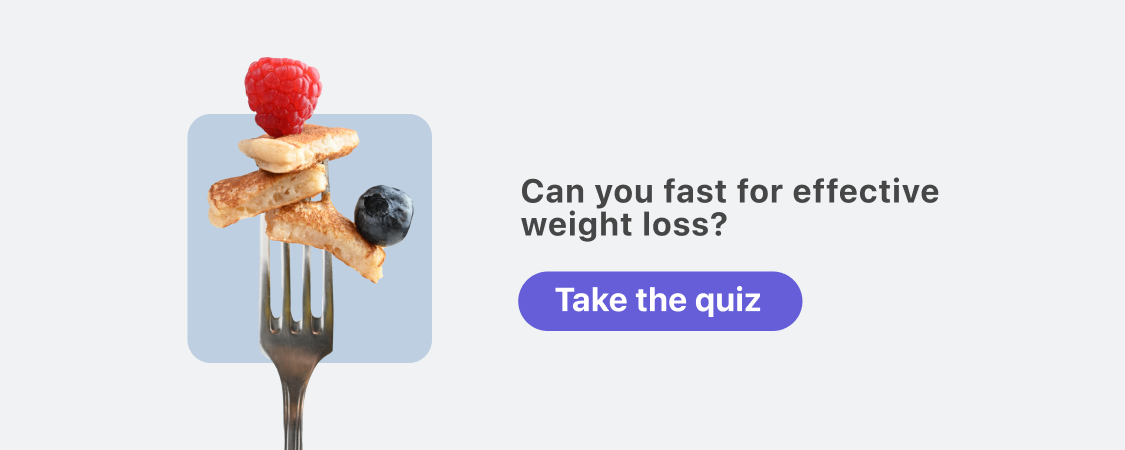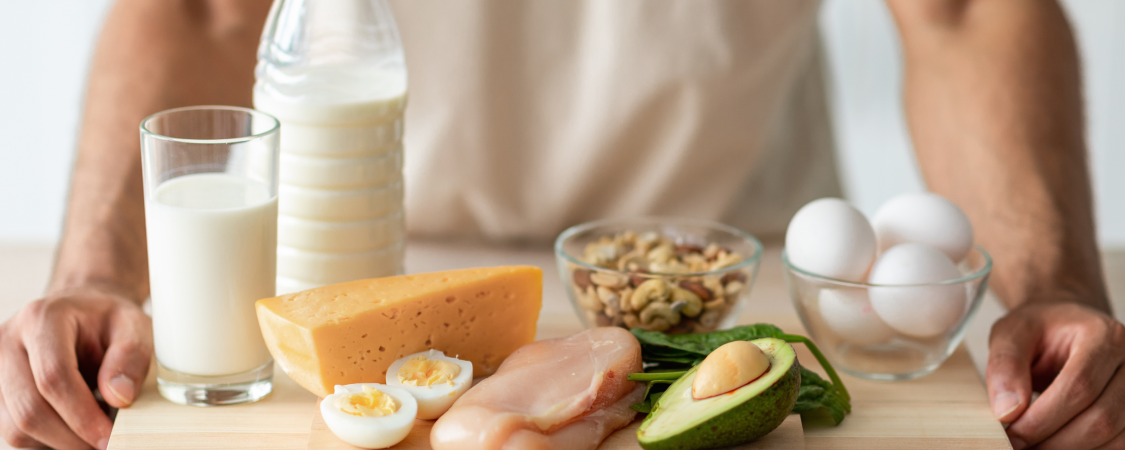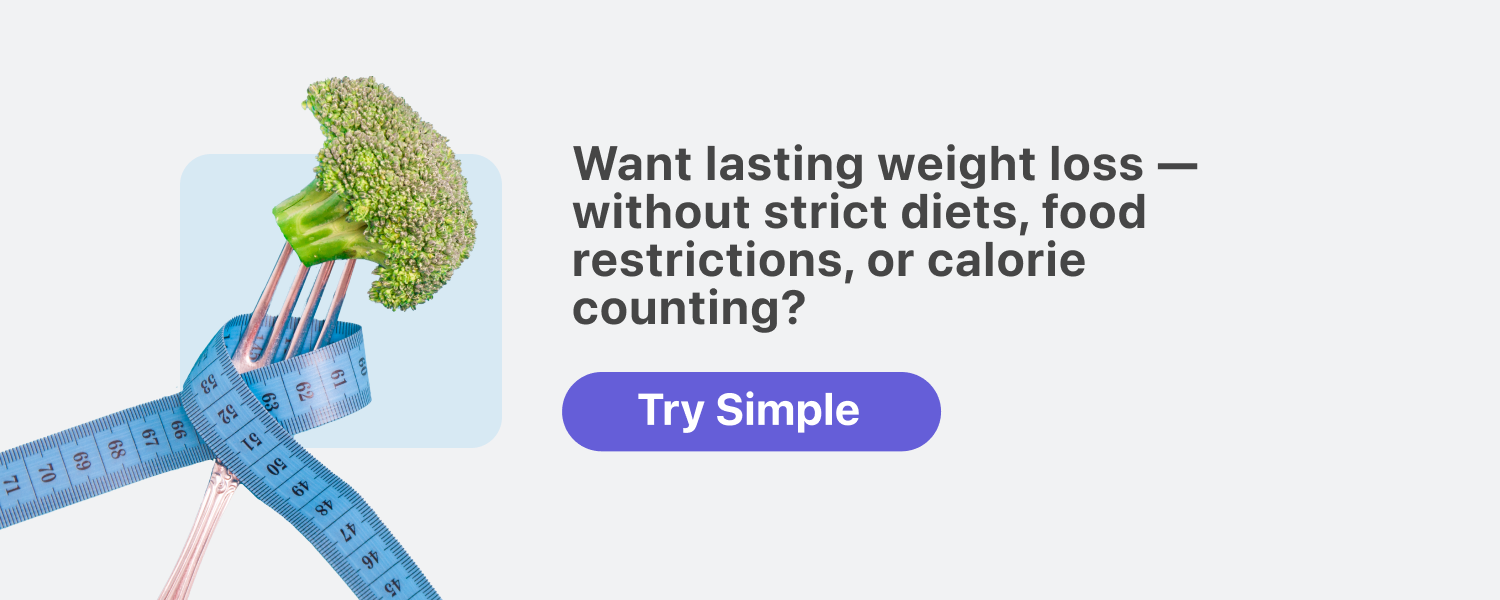Everything you need to know about the Warrior Diet — explained by Simple

The Warrior Diet is a type of intermittent fasting schedule that starts with a 20-hour fast that begins overnight and continues into the next day until being broken by a four-hour “feasting” window.

Based on the eating habits of ancient warriors and modern special forces soldiers — hence the name! — it’s not a schedule for everyone. If you’ve moved beyond intermittent fasting for beginners or are searching for a more rigorous fasting-based regimen, the Warrior Diet may be just the challenge you’re looking for!

What is the Warrior Diet?
Have you ever had one of those days where it feels like you’re moving nonstop, barely have time to make yourself some coffee or get a glass of water, and then come dinnertime, you realize you haven’t actually eaten anything since yesterday’s dinner?
If you have, you may have unintentionally followed the Warrior Diet for a day!
The Warrior Diet is a type of intermittent fasting schedule that involves an extended period of fasting (20 hours) followed by a short period of “feasting” in the evening (four hours). During this eating window, the most important thing is to listen to your hunger cues and choose nutritious foods that help you get the nutrients you need.
As with any fasting schedule, staying hydrated is a must: the Warrior Diet involves drinking even more than your usual amount of water, which the National Academy of Medicine suggests is around 13 cups (104 oz / 3.07 liters) for men and 9 cups (72 oz / 2.1 liters) for women. You can also drink coffee, tea, or other zero-calorie options.
Developed in 2001 by health and fitness author Ori Hofmekler, this fasting regimen takes its name and inspiration from both ancient warriors and modern-day soldiers. In prehistoric, nomadic times, our ancestors rarely ate in the morning. Instead, they would hunt and gather on empty stomachs until returning to feast at night.
Hofmekler studied these ancient ways of eating and compared them with his observations of the eating habits of his colleagues in the Israeli Special Forces. Both groups maintained high activity levels and extended fasting periods followed by shorter eating periods. They also maintained low body fat and lean muscle. Attributing these results to this specific combination of fasting and feasting, Hofmekler adapted these experiences into a diet meant to prime your body for strength, energy, and leanness and provide a simple, easy-to-follow strategy for how to burn fat.
How does the Warrior Diet work?
The Warrior Diet is a highly restrictive form of intermittent fasting, and it’s not for everyone. Plus, as we mentioned before, there’s not really any evidence to suggest it’s more effective than a less restrictive intermittent fasting approach. Although we don’t recommend this specific approach, as with any food routine, finding one that works for your body and lifestyle is critical.
At its core, the Warrior Diet operates under the principle that a lifestyle of timed eating, regular physical activity, and a high-protein, minimally-processed, whole-grain-rich meal plan can help you shed fat and gain energy.
As with any fasting schedule, Warrior Diet results can vary significantly, and there’s still not a ton of scientific evidence to support the Warrior Diet specifically. However, while more research needs to be done on this specific fasting schedule and how humans adapt to it, there is a lot of research on the benefits of intermittent fasting for metabolic health.[1]
When fasting for extended periods, your body is effectively tricked into thinking it’s being starved, so it starts to prepare your body for survival and more efficient energy storage and nutrient processing. This adaptation might mean producing more fat-burning hormones, lowering cholesterol, stabilizing blood sugar levels, creating changes in amino acid levels, and using protein more efficiently.[2]
To see whether the Warrior Diet might be a good fit for achieving your health goals, consult your doctor or dietitian and consider taking our Simple quiz.
How to follow the Warrior Diet
As proposed, the Warrior Diet follows three initial phases, each lasting around a week:
- Improving your body’s capacity to get rid of toxins by eating lots of veggies, plant proteins, and whole grains with small amounts of cheese and dairy.
- Improving your body’s ability to use fat for energy by eating more lean animal protein and nuts and eliminating grains and starches.
- Improving your body’s ability to use carbs for energy by cycling between high-carb and high-protein days.
Or you can simply follow the 20-hour fasting, four-hour “feasting” window routine, though you still want to focus on eating lean protein and whole grains during your feasting hours.
Either way, if you’re planning to try this type of fast, make sure you get your healthcare provider’s approval first.
If you’re used to an intermittent fasting schedule or have stuck to one in the past, extending your fasting period and shortening your eating window may not be much of a challenge. If you’re new to the fasting process, though, you may feel the potential effects more quickly.
These effects might include the following:
- persistent hunger or cravings
- dizziness or lightheadedness
- headaches
- irritability
- nutrient or electrolyte deficiencies
- binge-eating during your eating window
The best way to follow the Warrior Diet meal plan and avoid potential negative side effects while making sure your body is still getting the nutrition it needs is to eat nutrient-dense, health-promoting foods while drinking plenty of water during your fasting window. Some variations of the plan also allow snacking on high-protein, low-calorie things like raw veggies or eggs during the day to ensure your nutrient levels stay balanced.
One thing you shouldn’t need to do is count calories. Nutrients are your fuel, and calories are not an enemy you need to conquer!
If your doctor is on board with a Warrior Diet and you need some extra support in getting started or sticking to it, our experts outline some of the dos and don’ts below. If you’re ever unsure about your meals or fasting regimen, check out our Simple quiz to discover what schedules might work best for you and how to improve your overall nutrition.
Warrior Diet schedule and meal plan

While your specific strategy for how to meal plan should be based on your individual needs and lifestyle, there are a few key steps to follow if you’re planning to use the Warrior Diet framework.
The most important element of meal planning in the Warrior Diet is to make sure your meals during your eating window are high in protein, as protein is essential for building and maintaining muscle mass.[3] Consuming enough dietary protein is crucial for athletes or those looking to build strength or physical endurance.[4] So, especially if you’re vegan or vegetarian, make sure you’re prioritizing plant protein — like protein powders, tofu, and beans — and not just carbs!
Like with any meal planning, you also want to figure out why exactly you want to try the Warrior Diet and let that goal — as well as your nutritional needs, schedule, preferences, and budget — guide the meal planning and subsequent food-shopping process. You also want to decide ahead of time if you’re planning for one big meal during your feasting window or several smaller meals within that timeframe and if you want to go completely without food during the fasting window. That way, you can accurately plan for how many meals and snacks you might need.
Don’t forget to factor in any meals out and things that make water more interesting (like mint or lemon) so you’re motivated to stay hydrated. Keep in mind that you may also be especially reluctant to cook when you’ve reached the end of a long 20-hour fast and just want to dig into dinner.
Above all, remember: you want to count nutrients, not calories! Building recipes and serving sizes around nutritional needs and not scale readings or hunger pain cravings will not only help keep you motivated but also in a fighting state. Your doctor or dietitian can be a really helpful resource in ensuring you’re planning meals safely and effectively for your unique needs.
What should you eat on the Warrior Diet and what to avoid
When considering what to eat during any intermittent fasting schedule, you want to make sure your body is getting all the nutrients it needs to thrive. While specific foods and amounts may vary — and you should always consult your healthcare provider if you’re thinking of changing your eating habits — the Warrior Diet recommends eating certain foods and limiting or avoiding others.
Foods to eat:
- lean protein (like fish, beans, lentils, poultry, and tofu)
- whole grains (like oats, bulgar wheat, barley, and quinoa)
- raw produce (fruits and veggies)
- full-fat dairy products (like yogurt and cheese) or calcium-fortified alternatives (like almond milk)
- healthy fats (like avocados, whole eggs, and nuts)
Foods to limit or avoid:
- ultra-processed foods (like cookies, chips, and fast food)
- foods high in sugar (like candy, cakes, and desserts)
- foods high in sodium (like cured meats, pizza, and fried food)
- alcoholic beverages (which are often loaded with sugar)
- artificial sugars

How to control your hunger when doing the Warrior Diet
Warrior intermittent fasting can feel like an intense undertaking, especially if you’re used to several meals a day. If you find yourself feeling impossibly hungry at times, you’re definitely not alone in that!
There are several ways to hack hunger while fasting; however, the basic trick is to stay hydrated — we’re talking even more than usual — through water, coffee, and other low-calorie beverages. You also want to keep your blood sugar and electrolyte levels balanced. This balance comes from planning your Warrior Diet meals with the right nutrients in mind. Also worth mentioning is that in one version of the diet, you can consume small portions of raw fruits and veggies, hard-boiled eggs, and dairy during your fasting window.
How long should you follow the Warrior Diet?
How long you follow the Warrior Diet depends on your goals and how your body responds to the eating patterns involved.
First and foremost, if you’re experiencing any severe or persistent negative side effects, you should stop immediately and consult your doctor. The longer the fasting window, the more potential risks are involved, and while some initial discomfort may be expected as your body adjusts, your eating routine is definitely not a “no pain, no gain” situation.
Suppose you’re using the Warrior Diet to lose weight or burn fat more efficiently (there’s a difference in fat loss vs. weight loss!). In that case, you should keep a close eye on your targets, food choices, body composition, and physical activity levels. While some large-scale research does suggest that fasting even more rigidly for up to 21 days can promote weight and abdominal fat loss as well as reduced blood pressure,[5] we always recommend starting small and building up your routine. If you want to give the initial three-week cycle a try, and your healthcare team approves, go for it! Just remember this food routine might not always be compatible with your lifestyle long term, and the best plan for any health or nutritional goals is one that you can stick to safely.
The Warrior Diet and weight loss
Another thing to keep in mind if you’re considering the Warrior Diet for losing weight is that intermittent fasting, in general, has been linked to weight loss.[6] However, there still isn’t much research on the Warrior Diet fasting method specifically.
One pilot study of healthy, middle-aged adults found that eating one meal in a short timeframe during the early evening led to more weight loss than eating the same number of calories across several meals.[7] This eating routine also led to lower body fat and increased muscle mass. However, the participants who followed this fasting approach also experienced increased blood pressure and cholesterol, which increased the risk of heart disease.
Likewise, a systematic review of other studies researching whether intermittent fasting would help people in higher-weight bodies lose weight suggests that intermittent fasting isn’t necessarily more effective than basic calorie restriction.[8]
While there is clearly some evidence to support the idea of Warrior Diet weight loss, more research is needed to understand exactly how effective it might be and how it might affect different people. Our view is that, if you can achieve the same results with a less restrictive approach, that’s always going to be the better choice.

Health benefits and risks of the Warrior Diet
The challenge with studying intermittent fasting methods and their related benefits and risks is that so many different variables are involved that it becomes difficult to offer definitive results that can be confidently extrapolated to a wider population. Many researchers in relevant fields agree that further research is needed to study and clarify these methods and their effects on human health.
With that caveat in mind, while existing science doesn’t currently cover the specific Warrior Diet method, there is evidence to suggest that intermittent fasting, in general, may contribute to some health benefits and risks beyond weight loss. Again though, keep in mind that the longer the fasting window, the more potential for side effects.
Health Benefits
Decreased inflammation
Inflammation is connected to lots of chronic and acute illnesses, and some studies have linked intermittent fasting to reducing inflammation and inflammatory diseases.[9]
Better brain health
Some studies connect intermittent fasting to better cognition, longevity, and neuroplasticity, though others suggest these benefits may be more relevant to people with neurological diseases.[10,11,12]
Improved blood sugar control
One recent meta-analysis suggests intermittent fasting can improve both insulin resistance and glucose and lipid metabolism.[13] However, these studies primarily surround participants with metabolic disorders. Some studies have also suggested that with certain conditions, fasting may be connected to increased cholesterol, which would worsen blood sugar control.[2]
Health risks
Higher risk of disordered eating
Given the strict eating schedule involved in the Warrior Diet and the fact that it’s categorized by periods of undereating and overeating, following this fasting approach could lead to disordered relationships with food or exacerbate the disordered eating tendencies of binging and purging.[14]
Decreased concentration
Like the rest of your body, your brain needs certain nutrients from food to function. If you aren’t planning your meals according to your needs, fasting and hunger might deprive your brain of nutrients that regulate cognitive processes.[15]
Higher occurrences of mood swings, stress, and anxiety
While some studies suggest intermittent fasting may be connected to lower anxiety and depressive symptoms, others also suggest it could increase negative emotions and decrease instances of positive emotions.[16]
Is the Warrior Diet Safe?
The Warrior Diet definitely isn’t for everyone, and it’s essential to speak to your doctor before starting any fasting method or changing how you eat. You should be particularly cautious, however, if you:
- are pregnant, breastfeeding, or trying to conceive;
- have type 1 diabetes;
- have a history of disordered eating;
- have diabetes or another chronic medical condition;
- are extremely active;
- are prescribed medication (like hypertensives or any medications that need to be taken with food);
- have a BMI of less than 18.5; or
- are under 18 or 80 years old and older.
Even if you don’t fall into any of these categories, you will need to plan your Warrior Diet carefully (with the support and advice of your healthcare team) to make sure you’re getting enough nutrients and not neglecting anything your body needs.
Pros and cons of the Warrior diet
| Pros | Cons |
| Inexpensive | Requires very careful meal planning |
| Doesn’t require specialty ingredients | Inflexible in timing |
| Can binge during feasting window | Difficult to manage around life events |
| Offers an easy-to-follow structure | Exercise is challenging to manage |
| Not appropriate for everyone |
Pros
With a set eating routine (20 hours of fasting followed by four hours of eating in the evening) and clear guidance on what foods to prioritize and what foods to avoid in order to maximize nutritional benefits, the Warrior Diet is a fairly simple routine to follow (in theory). It also doesn’t require specialty foods or elaborate kitchen set-ups and gadgets, so your shopping bills won’t increase either. Quite possibly, its most appealing pro, though, is that as long as you’re eating nutrient-dense foods, you can live out the fantasy of sitting on the couch at night and eating until your stomach’s content while you watch your favorite show.
Cons
While you can, to some extent, eat what you want during your eating window, you still need to plan your meal(s) very carefully to ensure you’re getting all the nutrients you need for the day. Since the Warrior Diet stipulates that your eating window happens in the evening, it’s also fairly inflexible in routine. It can, therefore, be difficult to manage around social events, school or work schedules, and other life commitments — especially with respect to physical activity, since too much exertion without the proper fuel in your body can be dangerous. The most significant con, though, is that this eating routine isn’t appropriate for everyone. It requires serious forethought and consultation with medical professionals to make sure it’s a good fit for your body and lifestyle.
Is the Warrior Diet right for you?
Deciding whether or not the Warrior Diet schedule is right for you requires careful consideration of your goals, needs, body, lifestyle, and preferences.
Not sure how the Warrior Diet compares to other fasting methods? Let’s run through some of the other options.
The Warrior Diet vs. other time-restricted eating schedules
Keeping in mind that we generally don’t recommend fasting for 18+ hours without approval from your healthcare provider, a shorter fasting window in the form of 16:8 intermittent fasting, 14:10 intermittent fasting, or 12-hour intermittent fasting is more manageable and less risky without compromising on potential results — really a win all around! These intermittent fasting schedules are our most popular ones for a reason. The only real potential downside is that the shorter eating window of the Warrior Diet (or another version of 20:4 intermittent fasting) leaves less room for binging.
The Warrior Diet vs. the 5:2 diet
The 5:2 diet involves more restrictions (you’re eating only 500–600 calories) but for fewer days (you eat as you normally would for five days of the week). Because the 5:2 diet involves significant calorie restriction for 18+ hours on two days each week, we don’t recommend it without medical sign-off.
The Warrior Diet vs. alternate-day fasting
Effectively a more intense version of the 5:2 diet, alternate-day fasting involves more restrictions on some days (every other day you eat only 500–600 calories) while more flexibility on others (on non-fasting days, you don’t have fasting window restrictions). It’s another restrictive fast we don’t recommend without the green light from your healthcare team.
The Warrior Diet vs. OMAD (one meal a day)
With an OMAD schedule, you have an even shorter eating window (around one hour) and a more rigid schedule (you pretty much have to stick to eating your daily meal around the same time). As a highly restrictive form of fasting, it’s another one you really need to discuss with your doctor before attempting.
As with any way of eating, whether the Warrior Diet really works is hard to predict since results are tied very closely to many individual factors and circumstances — and it also depends on what kind of “work” you’re hoping to achieve! To see whether the Warrior Diet might be a good fit for meeting your health goals or happy weight, consult your doctor and consider taking our Simple quiz.

- Patterson RE, Laughlin GA, LaCroix AZ, Hartman SJ, Natarajan L, Senger CM, et al. Intermittent Fasting and Human Metabolic Health. J Acad Nutr Diet. 2015 Aug;115(8):1203–12.
- Wang Y, Wu R. The Effect of Fasting on Human Metabolism and Psychological Health. Dis Markers. 2022 Jan 5;2022:5653739.
- Carbone JW, Pasiakos SM. Dietary Protein and Muscle Mass: Translating Science to Application and Health Benefit. Nutrients [Internet]. 2019 May 22;11(5).
- Morton RW, Murphy KT, McKellar SR, Schoenfeld BJ, Henselmans M, Helms E, et al. A systematic review, meta-analysis and meta-regression of the effect of protein supplementation on resistance training-induced gains in muscle mass and strength in healthy adults. Br J Sports Med. 2018 Mar;52(6):376–84.
- Wilhelmi de Toledo F, Grundler F, Bergouignan A, Drinda S, Michalsen A. Safety, health improvement and well-being during a 4 to 21-day fasting period in an observational study including 1422 subjects. PLoS One. 2019 Jan 2;14(1):e0209353.
- Seimon RV, Roekenes JA, Zibellini J, Zhu B, Gibson AA, Hills AP, et al. Do intermittent diets provide physiological benefits over continuous diets for weight loss? A systematic review of clinical trials. Mol Cell Endocrinol. 2015 Dec 15;418 Pt 2:153–72.
- Stote KS, Baer DJ, Spears K, Paul DR, Harris GK, Rumpler WV, et al. A controlled trial of reduced meal frequency without caloric restriction in healthy, normal-weight, middle-aged adults. Am J Clin Nutr. 2007 Apr;85(4):981–8.
- Harris L, Hamilton S, Azevedo LB, Olajide J, De Brún C, Waller G, et al. Intermittent fasting interventions for treatment of overweight and obesity in adults: a systematic review and meta-analysis. JBI Database System Rev Implement Rep. 2018 Feb;16(2):507–47.
- Jordan S, Tung N, Casanova-Acebes M, Chang C, Cantoni C, Zhang D, et al. Dietary Intake Regulates the Circulating Inflammatory Monocyte Pool. Cell. 2019 Aug 22;178(5):1102–14.e17.
- Francis N, George & Anne Ryan Institute for Neuroscience, University of Rhode Island, 130 Flagg Road, Kingston, RI, 02881, US, Department of Psychology, Stony Brook University, 100 Nicolls Rd, Stony Brook, NY, 11794, US. Intermittent fasting and brain health: Efficacy and potential mechanisms of action. OBM Geriatrics. 2020 Jun 1;4(2):1–19.
- Brocchi A, Rebelos E, Dardano A, Mantuano M, Daniele G. Effects of Intermittent Fasting on Brain Metabolism. Nutrients [Internet]. 2022 Mar 17;14(6).
- Gudden J, Arias Vasquez A, Bloemendaal M. The Effects of Intermittent Fasting on Brain and Cognitive Function. Nutrients [Internet]. 2021 Sep 10;13(9).
- Yuan X, Wang J, Yang S, Gao M, Cao L, Li X, et al. Effect of Intermittent Fasting Diet on Glucose and Lipid Metabolism and Insulin Resistance in Patients with Impaired Glucose and Lipid Metabolism: A Systematic Review and Meta-Analysis. Int J Endocrinol. 2022 Mar 24;2022:6999907.
- Ganson KT, Cuccolo K, Hallward L, Nagata JM. Intermittent fasting: Describing engagement and associations with eating disorder behaviors and psychopathology among Canadian adolescents and young adults. Eat Behav. 2022 Dec;47:101681.
- Gómez-Pinilla F. Brain foods: the effects of nutrients on brain function. Nat Rev Neurosci. 2008 Jul;9(7):568–78.
- Berthelot E, Etchecopar-Etchart D, Thellier D, Lancon C, Boyer L, Fond G. Fasting Interventions for Stress, Anxiety and Depressive Symptoms: A Systematic Review and Meta-Analysis. Nutrients [Internet]. 2021 Nov 5;13(11).
